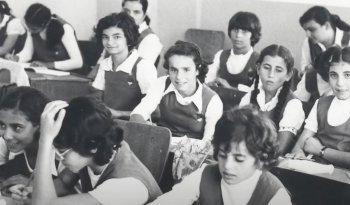
Home, Family, Mind, and Soul
Education
Education emerges from and shapes historical narrative, which in turn forms collective memory and identity during particularly impressionable and formative years. In East Jerusalem, education has therefore been a battleground since Israel occupied this side of the city in 1967.
Featured in This Topic
Educating the next generation: a wide-ranging discussion among diverse stakeholders
East Jerusalem schools are adamant that their curriculum must help Jerusalem children understand their lived realities.
Educating Palestinians in East Jerusalem is an effort facing pressures from the authorities on multiple fronts.
Who is responsible for what in East Jerusalem’s education system? You might be surprised.
How Israel systematically targets Palestinian university students in the occupied territories at a pivotal point in their lives
Demolition of the sole community primary school left youngsters no choice but to study outside.
Why are Palestinian schools in East Jerusalem going on strike and protesting? We spoke with a lifelong Jerusalem resident, parent, and community activist to find out.
An extreme shortage of classrooms and schools for Palestinian children, and a severe problem of overcrowding in schools that do exist, have led to a shocking situation in the city.
A formidable figure who dedicated her life to the care of orphans, education of girls and women, preservation of Palestinian culture, and social service

Dar Al Tifel Al Arabi, founded in 1948 by Hind al-Husseini, embodies resilience and dedication to preserving Jerusalem’s Arab and Jerusalemite identity.
An educator and social worker who founded a school for destitute girls and was fondly recalled as the “patron of us poor people”
Empowering innovation and entrepreneurship
This women-initiated community project evolved into a facility that nurtures children from nursery school through grade 8.
The Story in Numbers
143,221
Number of Palestinian children of compulsory school age (3–18) in Jerusalem (2022). Of these 73,942 are boys; 69,279 are girls. [1]
40,963
Number of Palestinian school-aged children in Jerusalem who are “invisible” (i.e. not registered in any known school in the city). This equates to 28.6 percent of Palestinian children of compulsory school age in the city. Of these, 20,076 are boys and 20,887 are girls (2022). [2]
12,097
Number of Palestinian children aged 3–6 in Jerusalem who are “invisible” (i.e. not registered in any known school in the city). This equates to 29.6 percent of all “invisible” children (2021–22). [3]
3,517
Number of additional classrooms needed to serve all Palestinian children of school age in Jerusalem, including “invisible” children (2022) [4]
2,682
Number of Palestinian children who dropped out of school in East Jerusalem in 2021–22 from grades 1–11. Of these, 1,657 were boys; 1,025 were girls. [5]
4
Number of supervising bodies that oversee different types of schools in the city and work at cross purposes or in open conflict with one another [6]
12.9
Percentage of Palestinian students studying for Israeli matriculation (Bagrut, using the Israeli curriculum) out of the total number of Palestinian school-aged children in East Jerusalem [7]
43
Number of girls per classroom in one Awqaf school in Jerusalem, a room that was originally designed to be a private living room in an apartment. (Each bedroom was allocated 28 girls in this case.) [8]
0.5–0.9
Square meters of space designated for each child in Jerusalem’s Awqaf and UNRWA schools, where space is extremely limited. The minimum amount of space that should be allocated per child in a normal classroom is 4.55 square meters (5.94 square meters for larger students). [9]
Notes
A general note: Data about schools in East Jerusalem is politicized and unreliable, because the fragmented education system has no single supervisory body responsible for centralizing data. Also, the system only counts children who are registered in the Population Registry, but for reasons unique to the Jerusalem context, many thousands likely remain unregistered, outside of the known data. Therefore, all data are likely only estimations at best.
[1] Per the Jerusalem municipality’s response to a Freedom of Information request submitted by the Israeli NGO Ir Amim, July 26, 2022. Ir Amim, “The State of Education in East Jerusalem 2021–2022: Annual Education Report: September 2022” (Jerusalem: Ir Amim, September 2022), 6.
[2] Per the Jerusalem municipality’s response to a Freedom of Information request submitted by the Israeli NGO Ir Amim, July 26, 2022. Ir Amim, “The State of Education in East Jerusalem 2021–2022,” 6.
[3] Ir Amim, “The State of Education in East Jerusalem 2021–2022,” 7n4.
[4] Ir Amim, “The State of Education in East Jerusalem 2021–2022,” 4.
[5] Ir Amim, “The State of Education in East Jerusalem 2021–2022,” 4.
[6] Rawan Ahmad Farid Nuseibeh, “Educational Exclusion under an Ethnocratic State: The Case of East Jerusalem,” PhD diss., Durham University, 2013, 77.
[7] Ir Amim, “The State of Education in East Jerusalem 2021–2022,” 4.
[8] Nuseibeh, “Educational Exclusion,” 126.
[9] Nuseibeh, “Educational Exclusion,” 125.
